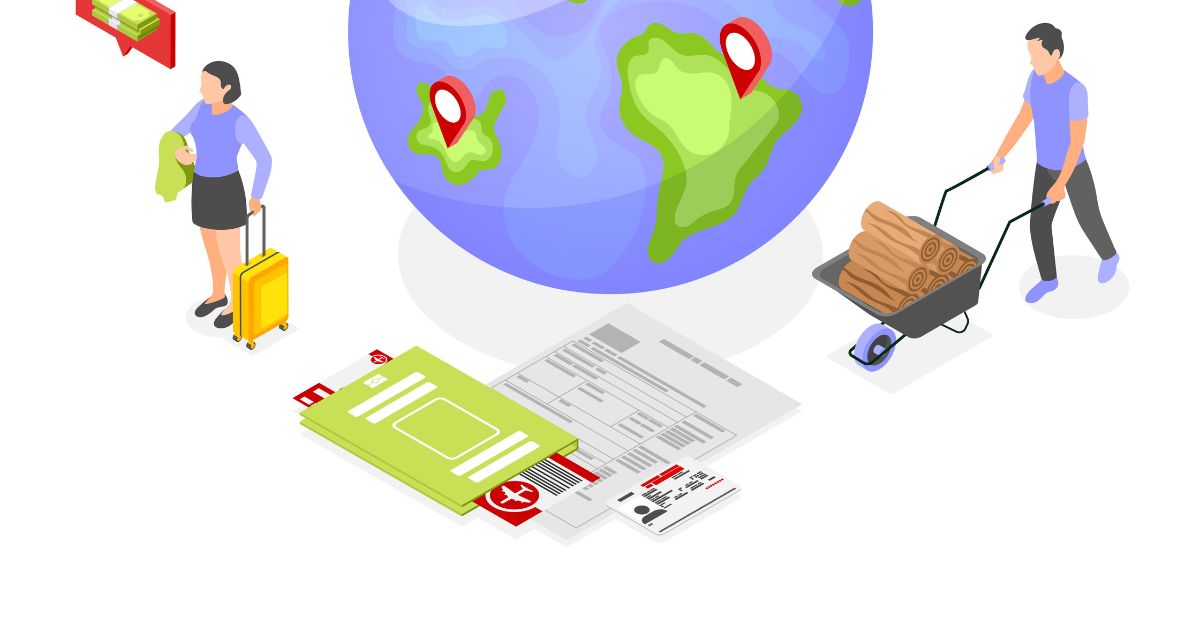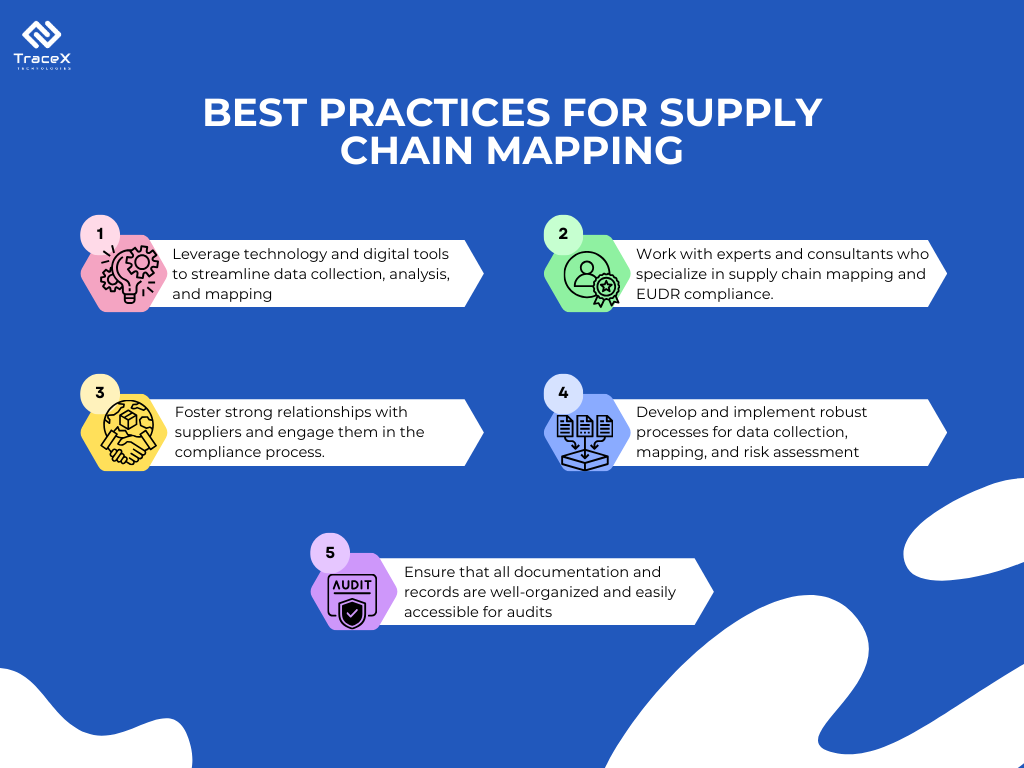Contact: +91 99725 24322 |
Menu
Menu
Quick summary: Discover the essential role of supply chain mapping in achieving EU Deforestation Regulation (EUDR) compliance. Learn how comprehensive mapping helps trace product origins, identify risks, and ensure adherence to deforestation-free standards. Explore practical strategies and tools to streamline your compliance efforts.

With the introduction of the EU Deforestation Regulations, the stakes of supply chain management have never been higher! How can you confidently guarantee that every step of your supply chain aligns with these new regulations? The answer lies in effective supply chain mapping.
Yet, without a clear, actionable strategy, even the most well-intentioned efforts can fall short, leaving your organization vulnerable to regulatory risks and reputational damage. For sustainability and compliance heads, ensuring that every product meets stringent deforestation-free criteria is no longer just a goal—it’s a mandate.
Supply chain mapping becomes more than just a tool; it’s your roadmap to compliance and sustainable success.
Key Takeaways
The EU Deforestation Regulation (EUDR) is a significant piece of legislation aimed at combating global deforestation and forest degradation. It requires businesses to demonstrate that certain commodities, including soy, palm oil, coffee, cocoa, rubber, wood, and cattle, are not linked to deforestation or forest degradation. The regulation stipulates that operators and large traders must provide evidence of the origin of these commodities, including geolocation data, to prove their compliance.
Supply chain mapping is a crucial component of the EUDR due diligence process. It involves identifying and documenting every stage of the supply chain, from raw material production to the final point of sale. This process enables businesses to ensure that their products meet EUDR requirements and avoid penalties associated with non-compliance.
According to the Accountability Framework, Supply Chain Mapping is defined as the process of identifying the actors in a company’s supply chain and the relationships among them.
Mapping your supply chain involves tracing the journey of the materials or products you purchase, starting from the final destination and working backward. This means identifying every entity involved in the trade and processing of these goods, all the way back to their original source. For example, the starting point could be a forest where timber is harvested or a farm where agricultural products are grown.
The depth of your supply chain mapping can differ depending on the situation. Sometimes, it’s enough to trace the product back to its country of origin or a particular region. However, there are cases where you’ll need to pinpoint the exact production locations, like specific forests or farms. This process often unfolds in stages; you might start by identifying the country of origin and then, based on the risks or circumstances, choose to either stop there or dig deeper into the precise areas where the materials were sourced.
Effective supply chain mapping starts with analyzing the material or product you’re sourcing. If it’s made up of several components or ingredients, each likely has a different origin, requiring your supply chain map to encompass all these varied sources.
Additionally, a single component or ingredient might be gathered from multiple locations before being combined at a certain stage in the supply chain. For example, a chocolate bar may contain cocoa sourced from multiple farms in different regions or countries, along with other ingredients like sugar and milk, each with its own distinct origin. Your supply chain map should, therefore, account for these varied sources, ensuring that each ingredient’s journey is accurately traced and documented.
Supply chain mapping serves several vital functions in the context of EUDR compliance:
Mapping the supply chain provides transparency into the flow of commodities from their origin to the final product. This transparency is essential for demonstrating that products are deforestation-free and sourced sustainably. By understanding the complete supply chain, businesses can trace the origin of their raw materials and ensure that they meet EUDR standards.
Effective supply chain mapping helps identify potential risks associated with deforestation and forest degradation. By assessing each link in the supply chain, businesses can pinpoint areas where deforestation risks may arise and implement measures to mitigate these risks. This proactive approach is critical for maintaining compliance and avoiding legal repercussions.
The EUDR requires businesses to maintain detailed records and documentation to prove comply to due diligence. Supply chain mapping facilitates the collection and organization of this documentation, ensuring that businesses can provide accurate and comprehensive reports when needed. Proper documentation also supports audits and inspections by regulatory authorities.
Supply chain mapping is essential for providing accurate inputs to the EU Due Diligence Registry. By systematically identifying and documenting every entity involved in the production, trade, and processing of materials, supply chain mapping ensures that operators have a comprehensive understanding of the origins of their products. This detailed knowledge allows for precise geolocation data, origin information, and the traceability of raw materials to be fed into the DDS, which is required by the EU to verify compliance with regulations such as the EU Deforestation Regulation (EUDR).
Supply chain mapping helps identify potential risks, such as the mixing of materials from deforested areas, enabling operators to mitigate these risks and provide robust evidence of compliance in their DDS submissions. Ultimately, this process enhances the accuracy and credibility of the DDS, ensuring that products placed on the EU market meet the strict legal and environmental standards set by the EU.
To achieve effective supply chain mapping and ensure compliance with the EUDR, businesses should follow a structured process.
1. Identify Supply Chain Participants
The first step in supply chain mapping is to identify all participants in the supply chain. This includes Farms, plantations, or extraction sites where raw materials are produced, companies or entities involved in processing, trading, or transporting raw materials, providers of goods and services that support the supply chain and businesses that sell or use the final products. Understanding the roles and responsibilities of each participant is crucial for mapping the entire supply chain accurately.
2. Gather and Analyze Data
Once the supply chain participants are identified, the next step is to gather and analyze relevant data. Collect geospatial data for each stage of the supply chain, including the coordinates of production areas and processing facilities. Obtain historical land use data to assess changes in land cover and identify potential deforestation risks. Gather data on suppliers sourcing practices, certifications, and adherence to sustainability standards. Analyzing this data helps in understanding the flow of commodities and identifying potential areas of concern.
3. Map the Supply Chain
For effective supply chain mapping, it’s crucial to gather specific information, including:
Supplier details: This includes identifying the supplier, their location, the nature of their business, and any relevant sustainability certifications.
Product details: Information about the type and description of the traded product, along with any associated certification claims, is essential.
One approach is to conduct a survey among your suppliers to collect this information, which can be efficiently managed using digital tools designed for online surveys.
Supply chain mapping can be based on declarations provided by suppliers through surveys, but it’s advisable to enhance the accuracy by collecting supporting documents or evidence that verify these declarations. This could include commercial invoices, bills of lading and certificates of origin. These documents help confirm key details, such as buyer and seller identification and product information, ensuring the reliability of the supply chain data.
4. Implement Risk Mitigation Strategies
Based on the supply chain map and risk assessment, businesses should implement strategies to mitigate identified risks. Work with suppliers who are certified by recognized sustainability standards to ensure deforestation-free sourcing, use technology and tools to enhance traceability and monitor the flow of commodities throughout the supply chain and support environmental conservation initiatives and collaborate with stakeholders to address deforestation risks. Implementing these strategies helps in reducing the risk of non-compliance and ensuring sustainable sourcing practices.
5. Monitor and Update
Supply chain mapping is an ongoing process that requires regular monitoring and updates. Businesses should continuously review and update geolocation data, historical land use information, and supplier records to reflect changes in the supply chain. Perform regular audits to verify compliance and identify any emerging risks or issues. Stay informed about changes in regulations and industry standards and adapt the supply chain map and practices accordingly. Regular monitoring and updates ensure that the supply chain remains compliant with the EUDR and that risks are effectively managed.

TraceX offers a comprehensive suite of solutions designed to support businesses in their supply chain mapping efforts. Our platform provides:
Partnering with TraceX ensures that you have the tools and support needed to achieve effective supply chain mapping and EUDR compliance.
Explore our EUDR Compliance platform
Supply chain mapping is a fundamental aspect of the EUDR due diligence process, essential for ensuring compliance and promoting sustainable sourcing practices. By understanding the importance of supply chain mapping, following best practices, and leveraging advanced tools and technologies, businesses can navigate the complexities of the EUDR and demonstrate their commitment to combating deforestation and protecting the environment.
As the EUDR enforcement date approaches, businesses must take proactive steps to map their supply chains, identify and mitigate risks, and maintain comprehensive documentation. By doing so, they can achieve compliance, avoid penalties, and contribute to a more sustainable future.
Supply chain mapping is crucial for EUDR compliance because it enables companies to trace the origin of raw materials back to their source. This process helps ensure that products placed on the EU market are deforestation-free and legally sourced, meeting the stringent requirements set by the EUDR. Without comprehensive supply chain mapping, it’s challenging to verify that materials have not contributed to deforestation, putting businesses at risk of non-compliance.
The EUDR requires businesses to provide detailed information about the entire supply chain, including the geolocation of production areas. Companies may need to map their supply chains down to the specific plots of land where raw materials are harvested. This level of detail is necessary to ensure that no deforestation has occurred after the cut-off date specified by the EUDR. The depth of mapping may vary depending on the complexity of the supply chain and the risk of mixing with non-compliant materials.
Digital tools can greatly enhance the efficiency and accuracy of supply chain mapping by automating the collection, organization, and verification of data. These tools can integrate geolocation information, track product movements, and facilitate communication between different entities in the supply chain. By using digital platforms designed for traceability, companies can ensure that their supply chain mapping efforts meet the EUDR’s stringent requirements, reducing the risk of non-compliance.
